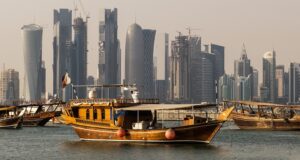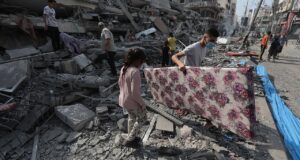by David Innerhuber – Junior Fellow
19th November 2013. Security and Defence, Issue 4, No. 4.
In the current round of nuclear talks with Iran, the international community must not be guided by dreams but by reality. Too often, the world has been deceived by the regime in Tehran. The sanctions have to be kept in place.
In his election campaign, president-elect Hassan Rouhani often criticised the aggressive stance of his opponent, Mahmoud Ahmadinejad, towards the West. According to Rouhani, Iran had to temper its voice in order to earn the trust of the international community regarding its nuclear programme. Once in office, Rouhani indeed started an unprecedented charm offensive towards the hereditary enemy. In western capitals the question now is whether the regime in Tehran really means business or if Rouhani was just sent to put the wolf in sheep’s clothing, as Israeli president Benjamin Netanyahu keeps warning. Afraid of any new military engagement in the Middle East, Western public opinion demonstrates a strong willingness to give Rouhani a chance. This, in turn, creates anxiety among the United States‘ Saudi and Israeli allies who are afraid the international community might agree to a shady deal containing loopholes through which the Iranian regime might eventually get the bomb.
Just how far Rouhani is willing (and authorised) to go will be determined in the coming days during the second round of negotiations in Geneva. These negotiations were imposed on Iran by the sheer economic pressure resulting from the international sanctions. Within Tehran’s political and religious elite, however, the opinion prevails that it is of vital national interest to have the bomb, as this would consolidate Iran’s position as hegemonic power in the Middle East. Under the nuclear shield, the regime could continue to play its destabilising role in the region without having to fear any serious consequences and thus would secure its retention of power. After investing billions of Dollars and enduring many hardships, the regime in Tehran will not stop short of having the bomb.
Many Western diplomats involved in the current negotiations still remember Rouhani from the 2003 nuclear talks, in which he headed the Iranian delegation. Before that, he was secretary of the Iranian national security council and as such significantly involved in the formulation of Iran’s nuclear strategy. Back then, he also perfected his negotiating strategy of ceding minor points to avoid something worse – for example the transfer of the Iran-dossier to the UN Security Council, as was the case in 2003. At the same time, however, Iran massively expanded those parts of its nuclear programme that could be classified as ‘civilian’ – mainly the enrichment of uranium – in order to create irreversible precedents. In an unofficial speech given in 2003, Rouhani declared that Iran’s situation would improve once they mastered the full fuel cycle because then the international community would realise that they had no other choice but to accommodate themselves with the fact of a nuclear Iran. The international community did not want Pakistan to have the bomb or Brasil to master the fuel cycle but both eventually succeeded and the world started to work with them.
Iran’s technological Capabilities
Today, Iran indeed masters the full fuel cycle that is necessary for the production of weapons-grade uranium and over the last couple of years it intensified its work on the heavy water reactor in Arak, which would open an additional path towards a plutonium bomb. According to James Clapper, US Director of National Intelligence, the regime in Tehran has not yet decided whether it actually wants to build a bomb. It is their goal, however, to overcome all technical obstacles on their way in order to gain the ability of a successful nuclear breakout. In this scenario, it could take the last steps towards the bomb (i.e. the enrichment of uranium to over 90%) in such a short period of time that it cannot be detected or prevented by any foreign power. In a recent study for the Nonproliferation Policy Education Center, Gregory Jones from the US government think tank RAND estimates that with its current capabilities Iran could produce the 50 pounds of highly enriched uranium that are necessary for a nuclear warhead within six weeks. According to David Albright, head of the Institute for Science and International Security in Washington D.C., this time frame could be down to two weeks by mid-2014 if Iran continues to expand its enrichment facilities at the current pace. Since the IAEA inspects these facilities only twice a month and Iran can easily prevent these inspections under false pretences, a nuclear breakout could indeed remain undetected. Even though the transformation of the weapons-grade uranium into a nuclear warhead might take another couple of months, this could be done in a secret location, again undetected by the international community.
Thus, the regime in Tehran has made a giant leap forward on its way to an irreversible nuclear weapons programme. It is not enough, therefore, to establish greater transparency and more frequent inspections, or to try to persuade the Iranians to stop enriching to 20%. What is needed to keep Iran from getting the bomb is a real roll-back of its nuclear programme, including the allegedly civilian parts of it. For the international negotiators, this means tackling the most important elements of the breakout strategy: First, Iran’s capability to enrich uranium, which can be maintained and improved even if they only enrich to 3.5% instead of 20% or higher. According to Albright, therefore, one of the first demands by the 5+1 Group should be that Iran does not increase the number of its uranium centrifuges. Second, the well-hidden enrichment facility in Fordow that can hardly be destroyed should Iran one day decide to set off to its final spurt towards the bomb. And third, the reactor that is currently under construction in Arak and that – once online – will produce weapons-grade plutonium but cannot be destroyed anymore for environmental reasons.
 Human Security Centre Human Rights and International Security Research
Human Security Centre Human Rights and International Security Research




